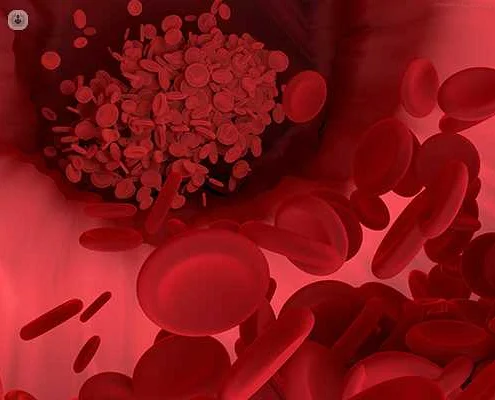Doctor Ulankina explained how blood clots form
Содержимое
In this article, Doctor Ulankina provides a clear explanation of how blood clots form in the body. Understanding the process of blood clot formation can help individuals identify potential risk factors and take preventive measures to maintain their health.
Blood clots are a common medical condition that can have serious consequences if left untreated. They occur when blood cells form a solid clump, obstructing the normal flow of blood. To gain a better understanding of this process, we turn to the expertise of Doctor Ulankina, a renowned hematologist who has dedicated her career to studying blood clot formation.
Doctor Ulankina’s research has provided valuable insights into the factors that contribute to the formation of blood clots. She explains that a combination of genetic and environmental factors can increase the risk of clot formation. Genetic mutations that affect the clotting proteins in the blood, such as factor V Leiden mutation, can predispose individuals to develop blood clots. Additionally, certain medical conditions, such as obesity, diabetes, and cardiovascular disease, can also increase the risk.
Doctor Ulankina emphasizes the importance of understanding the underlying mechanisms of blood clot formation. When a blood vessel is damaged, platelets gather at the site of injury to form a clot. This process, known as platelet aggregation, is a necessary step in preventing excessive bleeding. However, in certain situations, such as when there is a disruption in the normal flow of blood or an imbalance in the clotting process, blood clots can form inappropriately.
Doctor Ulankina’s research has also shed light on the role of inflammation in blood clot formation. Inflammation, which is the body’s response to tissue damage or infection, can activate the clotting cascade and promote the formation of blood clots. Chronic inflammation, often seen in conditions such as rheumatoid arthritis or inflammatory bowel disease, can increase the risk of clot formation.
By unraveling the complex mechanisms of blood clot formation, Doctor Ulankina’s work has paved the way for the development of new treatment strategies and preventive measures. Her insights highlight the importance of early detection and intervention to prevent the potentially harmful consequences of blood clots. With further research and advancements in the field, doctors like Doctor Ulankina continue to contribute to our understanding of this critical medical condition.
The Role of Blood Clots in Health and Disease
Blood clots play a crucial role in both maintaining health and contributing to various diseases. In normal circumstances, blood clotting is a protective mechanism that helps to prevent excessive bleeding after an injury. When a blood vessel is damaged, platelets in the blood form a plug at the site of the injury, stopping the bleeding.
However, problems arise when blood clots form unnecessarily or fail to dissolve properly. Excessive or inappropriate blood clotting can lead to various health conditions, such as deep vein thrombosis (DVT), pulmonary embolism, heart attack, and stroke. These conditions occur when a blood clot forms in a vein or artery, obstructing blood flow.
Factors that can contribute to the formation of blood clots include genetic predisposition, certain medical conditions (such as cancer and autoimmune disorders), surgery, prolonged immobilization, childbirth, and the use of certain medications (such as hormonal contraceptives).
To prevent blood clots and associated health issues, it is important to maintain a healthy lifestyle. Regular exercise, a balanced diet, avoidance of smoking, and maintaining a healthy weight can all help reduce the risk of blood clot formation. Additionally, individuals at higher risk may need to take specific preventive measures, such as wearing compression stockings or taking anticoagulant medications.
- Regular physical activity can help improve blood circulation and prevent blood clots.
- Avoiding smoking and reducing exposure to secondhand smoke can help protect blood vessels.
- Avoiding prolonged periods of immobility, especially during long flights or car rides, can help prevent blood clots in the legs.
In conclusion, understanding the role of blood clots in both maintaining health and contributing to disease is essential. By taking preventive measures and making lifestyle choices that promote healthy blood circulation, individuals can reduce the risk of blood clot formation and associated health complications.
Overview of Blood Clots and their Impact on the Body
A blood clot, also known as a thrombus, is a gel-like clump of blood that forms when blood changes from a liquid to a solid state. This process, known as coagulation, is a crucial mechanism that helps the body stop bleeding after an injury.
However, blood clots can also form inside blood vessels without an injury, leading to potentially serious health complications. When a blood clot forms in a vein, it can block the flow of blood, causing a condition known as deep vein thrombosis (DVT). If the clot breaks free and travels to the lungs, it can block blood flow and cause a pulmonary embolism, which can be life-threatening.
Blood clots can have a significant impact on the body. Depending on their location and size, they can cause symptoms such as swelling, pain, and warmth in the affected area. In some cases, blood clots can go unnoticed, especially if they are small and located in a deeper vein.
One of the major concerns with blood clots is their potential to travel to other parts of the body. This can lead to serious complications, such as stroke if the clot travels to the brain, or heart attack if it reaches the heart. Therefore, it is important to identify and treat blood clots promptly to prevent these potential complications.
Several factors can increase the risk of developing blood clots, including immobility, surgery, certain medical conditions, and certain medications. Understanding these risk factors and taking preventive measures can help reduce the risk of blood clots.
In conclusion, blood clots are abnormal formations of blood that can have a significant impact on the body. They have the potential to block blood flow and cause serious complications. Recognizing the risk factors and being aware of the signs and symptoms of blood clots can help in early detection and timely treatment.
Factors Influencing Blood Clot Formation

There are several factors that can influence the formation of blood clots. These factors can either increase the risk of clot formation or decrease the risk. It is important to understand these factors in order to better prevent and manage blood clot-related conditions.
1. Genetic Factors: Some individuals may have inherited genetic mutations that can increase the risk of blood clot formation. These mutations affect the clotting factors in the blood, making it more prone to clotting. Genetic testing can help identify these risk factors.
2. Age: The risk of blood clot formation generally increases with age. Older individuals are more likely to have underlying health conditions that can contribute to blood clot formation, such as diabetes, high blood pressure, and obesity.
3. Lifestyle Factors: Certain lifestyle habits can also influence blood clot formation. Sedentary behavior, smoking, excessive alcohol consumption, and a poor diet can all increase the risk of blood clot formation. Conversely, regular exercise and a healthy diet can help reduce the risk.
4. Medical Conditions: Certain medical conditions can increase the risk of blood clot formation. These include cancer, heart disease, stroke, and autoimmune disorders. It is important for individuals with these conditions to work closely with their healthcare providers to manage their risk.
5. Medications: Certain medications can also affect blood clot formation. Some medications, such as hormonal birth control and hormone replacement therapy, can increase the risk of blood clots. It is important to discuss the potential risks and benefits of these medications with a healthcare provider.
6. Surgery and Trauma: Surgery and trauma can increase the risk of blood clot formation due to the disruption of blood flow and damage to blood vessels. Individuals undergoing surgery or recovering from trauma may need additional preventive measures, such as blood thinners, to reduce the risk of clot formation.
7. Inflammation: Inflammatory conditions, such as arthritis and inflammatory bowel disease, can also increase the risk of blood clot formation. These conditions can cause inflammation in the blood vessels, making them more prone to forming clots.
8. Hormonal Changes: Hormonal changes, such as those occurring during pregnancy or menopause, can also affect blood clot formation. Hormonal fluctuations can alter the balance of clotting factors in the blood, increasing the risk of clot formation.
- Genetic factors
- Age
- Lifestyle factors
- Medical conditions
- Medications
- Surgery and trauma
- Inflammation
- Hormonal changes
By understanding these factors and working with healthcare providers to manage them, individuals can reduce their risk of blood clot formation and related complications.
Genetic and Environmental Factors Affecting Blood Clotting

Blood clotting is a complex process that can be influenced by both genetic and environmental factors. Understanding the interplay between these factors is crucial for developing effective strategies to prevent and treat blood clotting disorders.
Genetic factors play a significant role in determining an individual’s risk of developing blood clots. Certain genetic mutations can affect the production of proteins involved in the clotting process, leading to an increased risk of abnormal clot formation. For example, mutations in the genes encoding factor V and prothrombin can increase the risk of deep vein thrombosis and pulmonary embolism.
Other genetic factors that can influence blood clotting include variations in genes that control the levels of clotting proteins in the blood, such as antithrombin, protein C, and protein S. These variations can affect the balance between clot formation and clot breakdown, leading to an increased risk of clotting or bleeding disorders.
In addition to genetic factors, various environmental factors can also affect blood clotting. Obesity, for example, is associated with a chronic state of inflammation that can promote abnormal clot formation. Smoking, on the other hand, can damage the lining of blood vessels, making them more prone to clotting.
Certain medical conditions, such as cancer and autoimmune diseases, can also increase the risk of blood clot formation. These conditions can disrupt the normal balance between procoagulant and anticoagulant factors in the blood, leading to an increased risk of clotting.
Furthermore, lifestyle factors such as physical inactivity and poor diet can contribute to the development of blood clotting disorders. Lack of exercise can impair blood flow and increase the risk of clot formation, while a diet high in saturated fats and low in fiber can promote inflammation and clotting.
Overall, understanding the genetic and environmental factors that affect blood clotting is essential for identifying individuals at risk of clotting disorders and developing targeted prevention and treatment strategies. By addressing these factors, healthcare professionals can help reduce the burden of blood clot-related complications and improve patient outcomes.